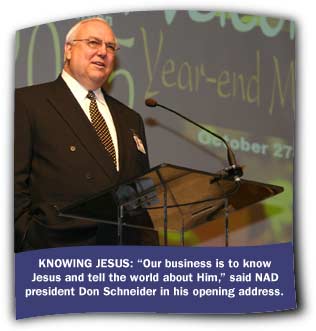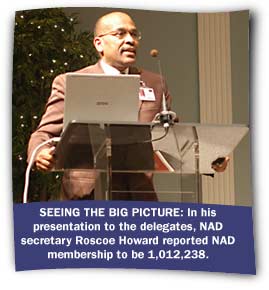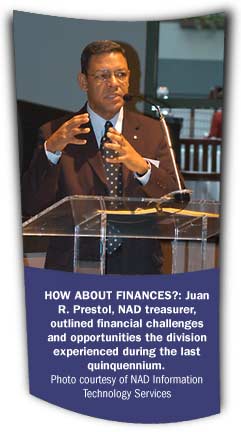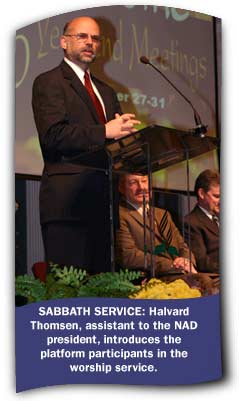
?Tell the World About Jesus?
NAD president Don Schneider calls for recommitment to Christ
and the mission of the church during Year-end Meetings 2005
BY SANDRA BLACKMER, NEWS EDITOR OF THE ADVENTIST REVIEW ultimedia presentations, personal testimonies, reports on evangelism and humanitarian work, and calls for personal and corporate recommitment emphasized this year?s theme of the North American Division (NAD) Year-end Meetings?to know Jesus more fully and to tell everyone possible about Him and His second coming.
ultimedia presentations, personal testimonies, reports on evangelism and humanitarian work, and calls for personal and corporate recommitment emphasized this year?s theme of the North American Division (NAD) Year-end Meetings?to know Jesus more fully and to tell everyone possible about Him and His second coming.
President Emphasizes Evangelism
?Our business is to know Jesus and tell the world about Him. That?s our business,? North American Division president Don Schneider told the nearly 200 delegates in attendance as he opened the session, held October 27-31. ?If you go home from here and you don?t know we talked about this, we have missed it.?
After emphasizing the church?s mission of evangelism and sharing his personal stories of helping and witnessing to neighbors, Schneider added, ?By the end of this quinquennium we?ll be turning in a billion dollars a year in tithe in this division?that?s big bucks. Let?s be sure we use every dime of it to help somebody find out about Jesus. . . . Because what we?re about here is reaching somebody for Jesus Christ.? Schneider announced that his goal for this quinquennium is to cut spending in various areas of church operation in order to free up more funds for evangelism.
 Highlighting the privilege of working for God and His church, Schneider advised the delegates that, ?If you ever get to the place where you don?t spend your time and energy thinking about how to reach people for the Lord Jesus Christ, then be honest enough to say ?I don?t belong here anymore; I?ll go work someplace else.? Because this is what we?re into. This is our goal here.?
Highlighting the privilege of working for God and His church, Schneider advised the delegates that, ?If you ever get to the place where you don?t spend your time and energy thinking about how to reach people for the Lord Jesus Christ, then be honest enough to say ?I don?t belong here anymore; I?ll go work someplace else.? Because this is what we?re into. This is our goal here.?
The president also led out in an emotional tribute to five church leaders who died during the past year?four in the Georgia-Cumberland Conference who were killed in a plane crash December 2, 2004: conference president David Cress, executive secretary and vice president for administration James Frost, assistant to the president Clayton Farwell, and communication director Jamie Arnall; and Manuel Vasquez, a vice president of NAD and director of Multilingual Ministries, who died as a result of cancer on January 29, 2005.
NAD Membership Passes 1 Million Milestone
NAD secretary Roscoe Howard reported to the delegates on the first afternoon of the session that the membership of the Adventist Church in North America has grown in the past 12 months by 13,788 members, or 1.4 percent, to a total of 1,012,238, as of June 30, 2005. Looking at the worldwide picture, Howard said, ?Although we?re the mother church, where it all started, we are now only 7.1 percent of the world church. That means that the world church [membership] is now at 14,256,078, as of June 30, 2005.? He added that 184,788 people were baptized in North America in the last five years.
Howard described a decreasing rate of growth in NAD as ?disturbing.? While the growth rate was 2.2 percent in 2000, the percentage in 2005 reached only 1.4. ?This is a challenge that we in North America really need to look at carefully and see if there is something we can do to change that,? said Howard.
?The rate that we are losing people is very alarming, and we need to look at some ways and means we can stop the hemorrhaging,? he added.
Statistics reported by Howard indicate that an average of 103 people have been baptized in the division every day from January 1 until June 30, 2005, and that for every 325 people in the United States, there is one Adventist. Total deaths during the past five years were 32,963, and 72,203 members were dropped from church books or are missing. The membership net increase was 92,211. These numbers, however, don?t reflect the members who transferred in from other divisions.
 Other statistics indicate a majority of female church members--62 percent--and almost one third of Adventists, approximately 300,000, are under the age of 30.
Other statistics indicate a majority of female church members--62 percent--and almost one third of Adventists, approximately 300,000, are under the age of 30.
Church Plants
Howard identified the Southern Union as having the highest number of church plants in the division at 316, and that the union is also one of the fastest growing in NAD. The total number of churches planted during the past five years in North America is 1,374. Although Howard described the job of being a church planter as ?one of the hardest,? he also said he believed it was a reason why the Southern Union region is experiencing rapid growth.
Challenges
Looking to the new quinquennium, Howard listed the following challenges for the church in North America:
?The one thing that we cannot afford is to allow our young people to leave us because the church is no longer relevant,? said Howard. ?We have to find ways to make sure that this message is still relevant to a post-modern society. We?ve got to package the truth in different ways.?
Howard also stressed the importance of unity in the church and the danger of North Americans becoming myopic??not seeing the big picture.? ?The minute we become myopic and begin to think that only we are important, and that we only need to take care of home and take care of ourselves, then we will truly lose out on the blessing that God intends for us,? he said.
?We need to develop policies that are inclusive and impact the very people we are writing those policies for,? he added. ?That means you might have to try to step outside of your particular culture and try to understand other cultures and how these policies impact other individuals.?
Three General Conference initiatives?a commission to study the use of tithe, a commission to study church structure, and the ?Tell the World? evangelism program?were also described during the report.
Treasurer Reports Financial Challenges and Opportunities
?We have been greatly blessed,? said NAD treasurer Juan R. Prestol as he began his 2005 treasurer?s report. ?There are areas of our division that are extremely needy . . . but compared to what many in other regions of the world have, we have been greatly blessed.?
Using a multimedia presentation, Prestol outlined the financial challenges and opportunities the NAD experienced during the last quinquennium?2000-2004. After describing the time period of March 1991 to March 2001 as covering the ?longest economic expansion in recent history,? Prestol listed the following factors that impacted church finances:
According to Prestol, the church has been attempting to meet these financial challenges by such efforts as developing remuneration and cost of living policy amendments, effecting retirement changes for regional and independent transfer employees, making adjustments to the health care assistance plan, initiating tithe percentage reductions, and addressing financial issues in some local conferences.
Tithes and Giving
Prestol reported that tithe income for the NAD increased 30 percent during the past five years, compared to the previous quinquennium. World mission offerings averaged 3.14 percent of tithe. Total membership giving totaled an estimated personal giving of $1,413,722,932 for a division membership of 1,006,317 (as of December 31, 2004), yielding a per capita giving total of $1,405.
 ?As of the end of September our tithe and offerings report indicates that the tithe division-wide is reflecting an 8 percent increase,? said Prestol. ?We are also pleased to report to you that at the end of the year of 2004 we are at 99 percent of working capital recommendation.?
?As of the end of September our tithe and offerings report indicates that the tithe division-wide is reflecting an 8 percent increase,? said Prestol. ?We are also pleased to report to you that at the end of the year of 2004 we are at 99 percent of working capital recommendation.?
The treasurer?s report delineated the following percentages in 2004 NAD tithe-dollar spending:
?I believe that as we embark together on this journey for the next five years, if we place our lives in the hands of the Lord, we will see many wonderful things?the hand of God leading us and helping the church throughout,? said Prestol.
?Go and Tell the World,? Says Paulsen
?People need the Lord. We need the Lord. I need the Lord,? said General Conference president Jan Paulsen as he began his Sabbath morning message during Year-end Meetings. Citing Matthew 24:14, he added, ?So Seventh-day Adventists, go and tell the world. Tell the people that the future will be better. And when we have done this, the Lord will come. This is our mission?plain and simple.?
Paulsen described God?s people today as pilgrims on the last leg of the journey, and emphasized the importance of getting ready personally for the coming of Jesus. He also encouraged listeners to develop their faith and not to give up hope. ?No one can live without hope for a better tomorrow,? he said. ?Hope is the lens through which we look to the future.?
Paulsen added that believers need to encourage one another. ?Let?s help make the load lighter for others. . . . Provide a sense of being ?safe? in the church. We are in this together.?
?Can He who called us on this journey see us through?? Paulsen asked. ?Oh, yes. The One who called you is faithful, and He will do it. Tell our people.?
The service concluded with Paulsen, Schneider, and NAD secretary and treasurer Howard and Prestol, together with their spouses, publicly recommitting their lives and their work to God and pledging to use every dollar of the Lord?s money to reach others for Jesus. Other GC and NAD church leaders were called to make the same commitment, and before the service ended, the entire audience joined the officers at the front of the auditorium or stood throughout the room to rededicate their lives to God?s service.
Responding in a Time of Crisis
Delegates who wondered how many Adventists were affected by the recent hurricanes in the southern states of Alabama, Florida, Louisiana, and Mississippi and how the church has responded to its members and others in those communities, had their questions answered on Friday morning of the session. Conference and union presidents, disaster response directors, Adventist Risk Management officers, and other church leaders?either in person or via a multimedia presentation prepared by the Hope Channel?gave detailed reports of damage to church properties and members? homes, and what Adventists throughout the North American Division have been doing to help the thousands affected by the storms.
More Resources |
Hurricane Katrina, a category-4 storm packing sustained winds of 140 miles per hour, was the largest and most devastating natural disaster to occur in the United States and resulted in the deaths of nearly 1,300 people. Estimated damages totaled $34 billion. Dealing with this disaster has been a major challenge to the Adventist Church.
Gordon Retzer, president of the Southern Union Conference, shared an experience of a small Adventist church in the Gulf Coast that had been severely damaged by a fallen tree. Eighteen families belonging to the church had lost everything to Katrina, including their homes. The members, however, were gathering supplies in the church building to provide help to the community. When Retzer asked them why they were there helping others when they had experienced so much loss themselves, they answered, ? ?Even though we?ve had devastation, we believe Jesus wants us to help our neighbors.? ?
?I?m glad I?m a part of a church that has members like that,? said Retzer. He also reported that Adventist students from throughout the division traveled to Bass Memorial Academy in Lumberton, Mississippi, which was particularly hard-hit by the storm, and helped clean up debris and repair damaged roofs.
?We had two churches that suffered serious damage, and one elementary school we lost completely,? said Gulf States Conference president Melvin Eisle during the program. ?One [member] we still cannot find. . . . Forty families [in our conference] have lost their homes?two of these as far as 250 miles inland.? Eisle also reported that disaster response volunteers from throughout the U.S. have distributed more than 300 semi-truck loads of supplies to hurricane survivors, and that Adventist Health System donated a 600-kilowat generator to aid in the recovery process.
Benjamin Browne, president of South Central Conference, said he and the conference?s communication director, Richard Norman, together with other volunteers, traveled to Gulf Port, Mississippi, five days after Katrina hit to help clean up debris and distribute supplies. ?A lady [in the region] had a tree that was leaning against her home . . . and a tree-removal service had indicated it would cost her $1,600 to have it removed,? said Browne, so he and his team cut it down and took care of it for her.
?It?s a surreal experience to go for miles and miles down blocks where people lived, and there?s no one there now. It?s a vacant community,? Southwestern Union Conference president Max Trevino told the delegates. He added that even though many churches and buildings are now gone, the greatest loss is the church members who left the area.
Stephen Orian, president of the Arkansas-Louisiana Conference, told delegates that out of ?the 11 churches that were at risk in Arkansas-Louisiana, we had over 100 of our families that either lost their entire homes or significant portions of them.?
Southwest Region Conference president Billy Wright reported that seven churches in his conference were affected by the storm, and that two members in his conference are still unaccounted for. Three shelters are operating in his region.
Vice president for NAD education Gerald Kovalski said that more than 1,200 students from 23 academy and college campuses throughout the division have assisted with hurricane relief. ?By nature students are activists. They want to do something, and they have,? said Kovalski.
According to Jere Patzer, president of the North Pacific Union Conference, even the very young have been doing their part to help. Patzer shared the story of two young girls in Meadow Glade, Washington, who arranged with a local Krispy Kreme Donut store to sell donuts donated by the store and give the funds to hurricane survivors. The girls raised a total of $10,400?$400 from donut sales, and $10,000 given to them by their grandfather.
ADRA and ACS
Charles Sandefur, president of Adventist Development and Relief Agency (ADRA), explained to the delegates that even though the organization does not directly respond to disasters within the North American Division, it assists disaster victims by working through partners such as Adventist Community Services (ACS) and Florida Conference?s Adventist Community Team Services (ACTS). ADRA has so far provided almost $1 million in aid monies and shipped more than $1.2 million worth of personal care supplies to hurricane survivors through warehouses operated by ACS. ADRA organizations from many regions of the world, such as Africa, Europe, and Canada, have contributed financially, said Sandefur. ?This shows that we belong to a wonderful global family.?
 Describing the need for long-term assistance, Sandefur said, ?One of the gifts we need to give each other is the gift of stamina.? Help is still needed long after the media and cameras are gone. He also reminded the delegates of the millions of people in other countries who are suffering because of famine, civil war, or other natural and political situations, and that they, too, are in need of assistance.
Describing the need for long-term assistance, Sandefur said, ?One of the gifts we need to give each other is the gift of stamina.? Help is still needed long after the media and cameras are gone. He also reminded the delegates of the millions of people in other countries who are suffering because of famine, civil war, or other natural and political situations, and that they, too, are in need of assistance.
NAD Adventist Community Services director Sung Kwon said 10,000 trained disaster response volunteers are active in the division and that ACS is recognized by FEMA (Federal Emergency Management Agency) as one of the top five national volunteer agencies to be deployed in disaster response operations. He added that ACS, the humanitarian agency of the Adventist Church that works within the United States and Bermuda, has received $2 million for hurricane relief?$1 million from local conferences and unions, and $1 million from direct contributions through ACS.
A Special Gift
When East-Central Africa Division president Geoffrey Mbwana heard about the hurricane disasters, he was attending a camp meeting in Nairobi, Kenya. ?We had to stop and pray when we heard about this devastation,? said Mbwana. But he and his church members did more than that. A few days before Year-end meetings began, Mbwana presented Schneider with a check for $10,000?the equivalent of 10 pastors? salaries for a year in that region of Africa. ?We had to help,? said Mbwana. ?You have helped us so often; you have helped us so much. We had to help.?
Other checks for hurricane relief donated during the program included $200,000 by GC president Jan Paulsen on behalf of the General Conference, $350,000 by Schneider on behalf of the North American Divison, and $100,000 by Inter-American Division president Israel Leito on behalf of his region.
?This is really not about hurricane relief,? Schneider told the Adventist Review. ?It?s about telling people about Jesus. Telling them that Jesus loves them and is there with them. It?s about letting them know that there is something better that they can look forward to.?
Schneider told the delegates that ?as a church we must be poised to invite people from the New Orleans area to find a new home, new neighbors, a new house built by the Lord Jesus Christ Himself.?
This two-hour program was taped at the session by the Hope Channel, and was broadcast during October and November. For more information, go to www.hopetv.org. To donate to hurricane relief, call 1-866-900-0123.
No Sleepy Sunday
Initiatives in compassion ministries, Adventist education, and Web-based local church communication highlighted the Sunday morning session of the North American Division?s annual meeting as leaders and delegates learned more about the diversity and range of the church?s services in the United States, Canada, and Bermuda.
Maitland de Pinto, Hope for Humanity/Ingathering director for the division, focused delegates? attention on a new effort to acquaint North American believers with the scope and complexity of the HIV/AIDS epidemic now sweeping through central and southern Africa. Tens of thousands of Adventist believers in Africa are suffering from HIV/AIDS, and church institutions, families, and congregations have been dramatically affected by the loss of members to the disease. Building on a recent awareness visit by pastors from the Chesapeake and Michigan conferences, the division is attempting to create contacts between North American congregations and counterparts in Africa through which resources, financial help, and compassion can flow.
A five-year research-based investigation of the impact of Adventist education on the academic performance of elementary and high school students was announced by Larry Blackmer, associate director of education for the division. Dubbed ?CognitiveGenesis,? the study was conceived and is being conducted by La Sierra University?s School of Education and follows up on the landmark 1990s research on the transmission of values in Adventist education known as ?ValueGenesis.? Noting that some parents question the academic viability of Adventist K-12 education because they lack empirical data that the system successfully promotes students? intellectual development, Blackmer underscored the strengths of the research model being used in the investigation, as well as efforts to control such variables as socio-economic status, gender, race, and prior achievement that could otherwise skew study results. The current 2005-2006 school year is the pilot year of the study and is being conducted in the Pacific Union Conference. Data will be collected for an additional three years at hundreds of school sites across North America, and a final report prepared by 2010.
Fred Kinsey, new NAD assistant to the president for Communication, described an initiative by the NAD to provide any participating Adventist congregation with a basic Worldwide Web presence. ?Adventist Church Connect? will offer local congregations a Web site that will feature contact information (church address, map, service times, etc.) and be updated weekly with devotional material, articles, and direct connections to ministries such as LifeTalk Radio and HopeTV.
Also featured in Sunday morning?s business were celebrations of the ministries of three persons leaving leadership posts at the division. Noelene Johnsson, director of children?s ministries, retired after 18 years of service. The division?s children?s ministries program began with her election in 1988, and has featured the introduction of many news resources, including the GraceLink Sabbath school curriculum. Mary Maxson, women?s ministries director since 2000, has accepted a position as associate pastor of the Paradise, California, congregation. James Gilley, vice president for evangelism, announced that he is returning to Texas as the pastor of a Dallas congregation after four and a half years at the Silver Spring, Maryland, headquarters.
The last item of the Sunday session and the Year-end Meeting was an animated discussion of a proposal to trim the size of the North American Division Committee. A draft document distributed at the meeting recommended reducing the numbers of laypersons, pastors, teachers, and division department heads on the committee to achieve cost reductions associated with attendance. While agreeing that some reduction in number might achieve greater efficiency, delegates strongly opposed the proposed reductions, and voted to ask the division leadership to prepare recommendations that could be implemented at the end of the current quinquennium in five years.
In Conclusion
?When it?s all said and done, it?s not what we do here that really counts,? said Schneider at the close of the meetings. ?What really counts is what you do in your community to help people know about Jesus.
?I will speak to you only this: Jesus is coming soon. Even so, come Lord Jesus. But take my boy, take my daughter, take my neighbors when You come to take me to Your kingdom.?